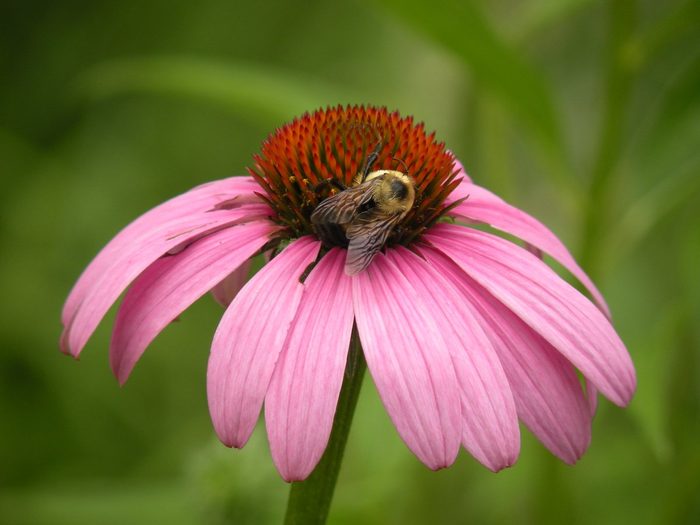Save the bees
By Chuck
Gill
Warm, wet weather conditions and changing climate negatively influence the nectar intake and nutritional health of honey bees, but maintaining large tracts of grassy natural habitat with flowering plants around apiaries may help to mitigate the detrimental effects of climate, according to a new study by an international team of researchers.
The pollination provided by bees and other insects is critical for crop production and ecosystem health, but some wild and managed pollinator populations have declined significantly around the world, the researchers noted.
A major driver of these declines is loss of
habitat and flowering plants — the food sources for pollinators — likely due to
climate change and shifts in land use.
“However, the effects of land cover can be specific to a particular location,” said lead author Gabriela Quinlan, postdoctoral scholar in entomology in Penn State’s College of Agricultural Sciences.
“Previous research looking at the
influence of land cover, weather and climate on bee health found a greater
impact from weather and climate,” she said. “But no studies have monitored
colonies over sufficient time and space to determine how climate and weather
interact with landscape quality to affect honey bees’ ability to gather nectar
in North America.”
A variety of factors affect the
availability of flowering plants across locations and time periods, Quinlan
explained, so researchers needed a standard, low-effort method for surveying
honey bee colonies’ intake of food resources. They found that the use of
automated hive scales can provide colony-level measurements of hive performance
by monitoring changes in honey bee colony weight within and across days and
seasons.
“Honey bee colonies must collect and
store foraged pollen and nectar to support a large population and continuous
brood-rearing over the growing season,” she said. “So, changes in colony weight
are closely tied to changes in food availability over time. This colony weight
data may be a proxy for estimating landscape-level flowering resources.”
To estimate the relative importance
of climate, weather and land cover on flowering plant resources, the
researchers combined hive scale data from several honey bee studies spanning
five years, 162 apiary locations and 644 colonies in seven states — Michigan,
Minnesota, North Dakota, Ohio, Pennsylvania, South Dakota and Wisconsin. They
focused on the period of late summer nectar flow in July and August, a critical
time when colonies must collect sufficient resources to survive the winter.
For each apiary, the researchers
obtained temperature and precipitation data and quantified the total areas of
various land covers within a 2-kilometer radius, which is the average foraging
distance that honey bees travel. Land covers were categorized as grass crops,
woody-herbaceous crops, grassy-herbaceous natural land, woody natural land or
developed land.
The team performed a statistical
analysis to model the maximum weight gain of colonies across the region, taking
into account land cover, weather and climate variables.
The researchers, who published their
results recently in Environmental Research Letters, found
that colonies gained an average of almost 20 kilograms (nearly 44 pounds) in
July and August and that colonies in wet and warm climates had the lowest
weight gain compared to colonies in cool, dry climates.
“There was a positive correlation
between the proportion of grassy–herbaceous natural land around the colonies
and greater colony weight gain, indicating that this type of land cover can
help moderate the detrimental effects of warm and wet climates,” said study co-author
Christina Grozinger, Publius Vergilius Maro Professor of Entomology and
director of Penn State’s Center for Pollinator Research.
“Our data indicated that
grassy–herbaceous land can enhance colony weight gain by up to 3.5 kilograms
across climates,” she said. “On the other hand, woody natural land was
negatively correlated with rates of colony weight gain.”
For colonies in warm and wet
climates to gain weight comparable to the worst-performing colonies in cool and
dry climates, grassy–herbaceous land must account for more than 25% of the land
area within 2 kilometers of the apiary, Grozinger noted.
The researchers said that long-term
monitoring across climactic zones using hive scales could offer a wealth of
information on which climates support the most productive floral communities
for bees and how the ranges of these plants may shift as the climate continues
to change.
“Based on our findings, better
models could be developed using climate and weather data to predict outcomes
for honey bee colonies ahead of the growing season to help support beekeeper
decision making,” Quinlan said. “Land managers could also improve floral
resources for managed and wild bees by preserving grassy–herbaceous land covers
and planting climate-resilient mixes of flowering species across the
northcentral United States.”
The U.S. Department of Agriculture’s
National Institute of Food and Agriculture; the Foundation for Food and
Agricultural Research; the Wisconsin Department of Agriculture, Trade and
Consumer Protection; the USDA Farm Service Agency; the USDA Natural Resources
Conservation Service; the Roger and Barbara Hoopingarner Endowed Graduate
Fellowship in Entomology at Michigan State University; and the North American
Pollinator Protection Campaign’s Honey Bee Health Improvement Grant Program
supported this research.
